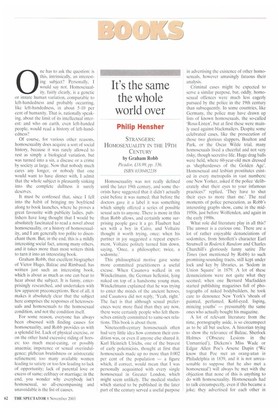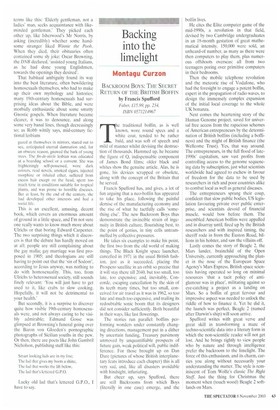It's the same the whole world over
Philip Hensher
STRANGERS: HOMOSEXUALITY IN THE 19TH CENTURY by Graham Robb Picador, £18.99; pp. 336, ISBN 0330482238 Qne has to ask the question: is this, intrinsically, an interesting subject? Personally, 1 would say not. Homosexuality, fairly clearly, is a genetic or innate human variation, comparable to left-handedness and probably occurring, like left-handedness, in about 5-10 per cent of humanity. That is, rationally speaking, about the limit of its intellectual interest: and who on earth, even left-handed people, would read a history of left-handedness?
Of course, for various other reasons, homosexuality does acquire a sort of social history, because it was rarely allowed to rest as simply a biological variation, but was turned into a sin, a disease or a crime by society at large. Now that nobody much cares any longer, or nobody that one would want to have dinner with, I admit that the whole subject is pleasantly sinking into the complete dullness it surely deserves.
It must be confessed that, since I fell into the habit of bringing my boyfriend along to book launches, where he proves a great favourite with publicity ladies, publishers have long thought that I would be absolutely fascinated to read a novel about homosexuality, or a history of homosexuality, and I am generally too polite to disenchant them. But, in the end, this is a mildly interesting social fact, among many others, and it takes more than most writers think to turn it into an interesting book.
Graham Robb, that excellent biographer of Victor Hugo, Balzac and Rimbaud, has written just such an interesting book, which is about as much as one can bear to hear about the subject. It is funny, enterprisingly researched, and undertaken with few apparent preconceptions. Best of all, it makes it absolutely clear that the subject here comprises the responses of heterosexuals and homosexuals to the homosexual condition, and not the condition itself.
For some reason, everyone has always been obsessed with finding causes for homosexuality, and Robb provides us with a splendid list. Lack of physical exercise, or on the other hand excessive riding of horses; too much meat-eating, or possibly anaemia; impotence or sexual overindulgence; plebeian brutishness or aristocratic refinement; too many available women leading to satiety or too few leading to lack of opportunity; lack of parental love or excess of same; celibacy or marriage; in the end, you wonder why everybody isn't homosexual, so all-encompassing and unavoidable is the list of causes. Homosexuality was not really defined until the later 19th century, and some theorists have suggested that it didn't actually exist before it was named; that before the doctors gave it a label it was something which simply offered a series of possible sexual acts to anyone. There is more in this than Robb allows, and certainly some surprising people gave it a go. Flaubert had sex with a boy in Cairo, and Voltaire thought it worth trying, once: when his partner in joy suggested a repeat experiment, Voltaire politely turned him down, saying, 'Once, a philosopher; twice, a sodomite.'
This philosophical motive gave some more committed practitioners a useful excuse. When Casanova walked in on Winckelmann, the German hellenist, lying naked on top of a handsome young man, Winckelmann explained that he was trying to enter the minds of the ancient heroes, and Casanova did not reply, 'Yeah, right.' The fact is that although sexual preferences were more fluid than they are now, there were certainly people who felt themselves entirely committed to same-sex relations. This book is about them.
Nineteenth-century homosexuals often had very little idea how common their condition was, or even if anyone else shared it. Karl Heinrich Ulrichs, one of the bravest of early polemicists, thought at first that homosexuals made up no more than 0.002 per cent of the population — a figure which, if correct, would mean that I was personally acquainted with every single homosexual in Greater London, which might seem unlikely. The medical studies which started to be published in the later part of the century served a useful purpose in advertising the existence of other homosexuals, however amusingly fatuous their analysis.
Criminal cases might be expected to serve a similar purpose, but, oddly, homosexual offences were much less eagerly pursued by the police in the 19th century than subsequently. In some countries, like Germany, the police may have drawn up lists of known homosexuals, the so-called 'Rosa-Listen', but at first these were mainly used against blackmailers. Despite some celebrated cases, like the prosecution of those two glorious slappers, Boulton and Park, or the Oscar Wilde trial, many homosexuals lived a cheerful and not very risky, though secretive life. Huge drag balls were held, where 60-year-old men dressed as 'shepherdesses of the Golden Age". Homosexual and lesbian prostitutes existed in every metropolis in vast numbers; one New Yorker, asked if the police 'deliberately shut their eyes to your infamous practices?' replied, 'They have to shut their eyes to more than me.' The real moments of police persecution, as Robb's interesting graphs show, came in the mid1950s, just before Wolfenden, and again in the early 1990s.
What role did literature play in all this? The answer is a curious one. There are a lot of rather enjoyable denunciations of sodomites, from Smollett's character Earl Strutwell in Roderick Random and Charles Churchill's gloriously funny satire The Times (not mentioned by Robb) to such promising-sounding tracts, still kept under lock and key by libraries, as 'Sodom in Union Square' in 1879. A lot of these denunciations were not quite what they seemed; when one Bernard Macfadden started publishing magazines full of photographs of naked bodybuilders, he took care to denounce New York's 'shoals of painted, perfumed. Kohl-eyed, lisping, mincing youths' — presumably the same ones who actually bought his magazine.
A lot of relevant literature from the time, pornography aside, is so circumspect as to be all but useless. A historian trying to show the relevance of Balzac. Sherlock Holmes (Obscure Lesions in the Unmarried'), Dickens's Miss Wade or Edgar Allen Poe's Arsene Dupin ('We know that Poe met an orang-utan in Philadelphia in 1839, and it is not unreasonable to suppose that he also met a homosexual') will always be met with the objection that none of this is anything to do with homosexuality. Homosexuals had to talk circumspectly, even if this became a joke; they advertised for each other in terms like this: 'Elderly gentleman, not a ladies' man, seeks acquaintance with likeminded gentleman.' They picked each other up, like Isherwood's Mr Norris, by asking (incredibly) whether some handsome stranger liked Winnie the Pooh. When they died, their obituaries often contained some sly joke: Oscar Browning, the DNB declared, 'assisted young Italians, as he had done young Englishmen, towards the openings they desired'.
That habitual ambiguity found its way into the best literature, often bewildering homosexuals themselves, who had to make up their own mythology and histories; many 19th-century homosexuals had surprising ideas about the Bible, and were morbidly enthusiastic about some smutty Gnostic gospels. When literature became clearer, it was to denounce, and along some very banal lines, though decreasingly so; as Robb wittily says, mid-century fictional lesbians gazed at themselves in mirrors, stared out to sea, anticipated eternal damnation and, for an obscure reason, gnawed the bark of young trees. The fin-de-siecle lesbian was educated at a boarding school or a convent. She was frighteningly self-possessed, wore dark colours, read novels, smoked cigars, injected morphine or inhaled ether, suffered from excess hair except on the head, spent too much timc in conditions suitable for tropical plants, and was prone to horrible diseases. But at least, by the end of the century, she had developed other interests and had a social life.
This is an excellent, amusing, decent book, which covers an enormous amount of ground in a little space, and I'm not sure one really wants to know much more about Ulrichs or that boring Edward Carpenter. The two surprising things which it discovers is that the debate has hardly moved on at all; people are still complaining about the gay mafia; gay marriage was first proposed in 1905; and theologians are still having to point out that the 'sin of Sodom', according to Jesus anyway, was nothing to do with homosexuality. This, too, from Ulrichs to heterosexual society, still sounds finely relevant: 'You will just have to get used to it, like crabs to slow cooking. Hopefully, it will not be detrimental to your health.'
But secondly, it is a surprise to discover quite how visible 19th-century homosexuals were, and not always caring to be visibly admirable; Edmund Gosse was glimpsed at Browning's funeral going over the Baron von Gloeden's pornographic photographs of Sicilian youths in the pew. Or then, there are poets like John Gambril Nicholson, publishing stuff like this: Smart looking lads arc in my line; The lad that gives my boots a shine, The lad that works the lift below, The lad that's lettered G.P.O.
Lucky old lad that's lettered G.P.O., I have to say.



































































































 Previous page
Previous page